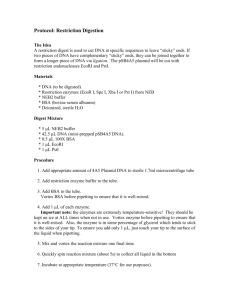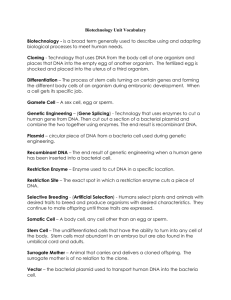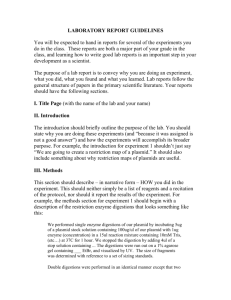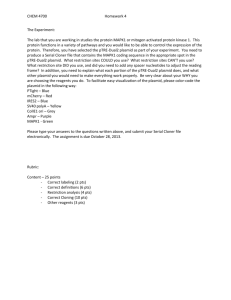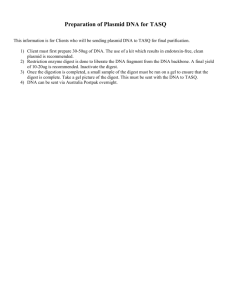ACTIVITY 6.1.1 CONSTRUCTING A PLASMID MAP
advertisement
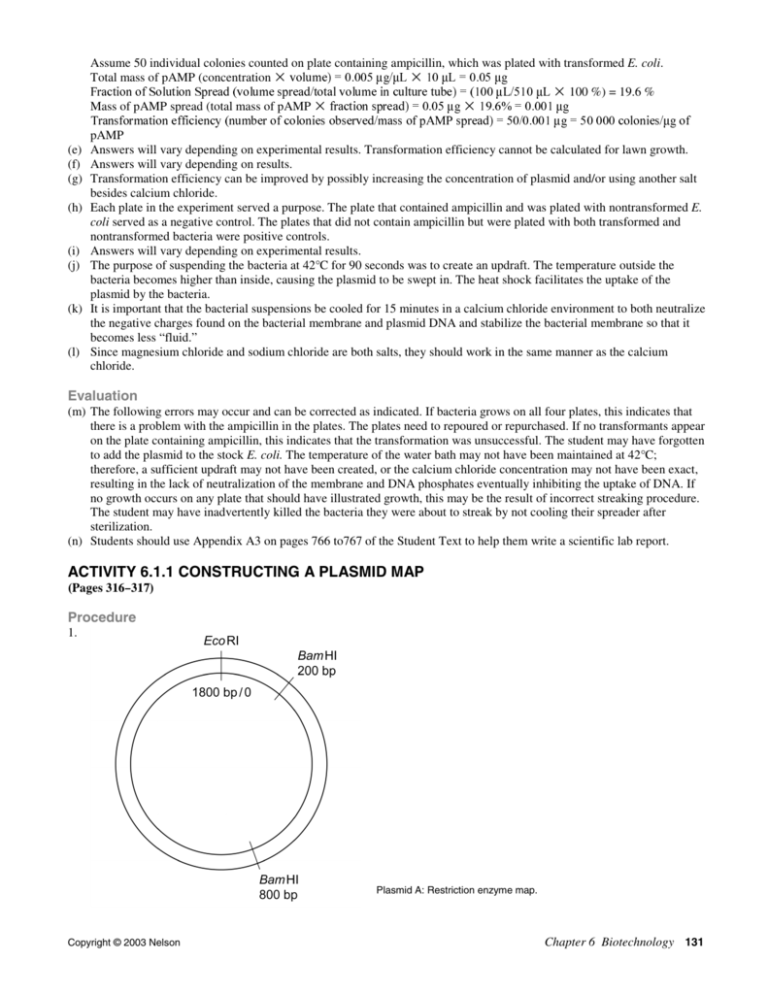
Assume 50 individual colonies counted on plate containing ampicillin, which was plated with transformed E. coli. × Total mass of pAMP (concentration × × 100 %) = 19.6 % Mass of pAMP spread (total mass of pAMP × × YROXPH J / / J )UDFWLRQ RI 6ROXWLRQ 6SUHDG YROXPH VSUHDGWRWDO YROXPH LQ FXOWXUH WXEH / / IUDFWLRQ VSUHDG J J 7UDQVIRUPDWLRQ HIILFLHQF\ QXPEHU RI FRORQLHV REVHUYHGPDVV RI S$03 VSUHDG J FRORQLHVJ RI pAMP (e) Answers will vary depending on experimental results. Transformation efficiency cannot be calculated for lawn growth. (f) Answers will vary depending on results. (g) Transformation efficiency can be improved by possibly increasing the concentration of plasmid and/or using another salt besides calcium chloride. (h) Each plate in the experiment served a purpose. The plate that contained ampicillin and was plated with nontransformed E. coli served as a negative control. The plates that did not contain ampicillin but were plated with both transformed and nontransformed bacteria were positive controls. (i) Answers will vary depending on experimental results. (j) The purpose of suspending the bacteria at 42°C for 90 seconds was to create an updraft. The temperature outside the bacteria becomes higher than inside, causing the plasmid to be swept in. The heat shock facilitates the uptake of the plasmid by the bacteria. (k) It is important that the bacterial suspensions be cooled for 15 minutes in a calcium chloride environment to both neutralize the negative charges found on the bacterial membrane and plasmid DNA and stabilize the bacterial membrane so that it becomes less “fluid.” (l) Since magnesium chloride and sodium chloride are both salts, they should work in the same manner as the calcium chloride. Evaluation (m) The following errors may occur and can be corrected as indicated. If bacteria grows on all four plates, this indicates that there is a problem with the ampicillin in the plates. The plates need to repoured or repurchased. If no transformants appear on the plate containing ampicillin, this indicates that the transformation was unsuccessful. The student may have forgotten to add the plasmid to the stock E. coli. The temperature of the water bath may not have been maintained at 42°C; therefore, a sufficient updraft may not have been created, or the calcium chloride concentration may not have been exact, resulting in the lack of neutralization of the membrane and DNA phosphates eventually inhibiting the uptake of DNA. If no growth occurs on any plate that should have illustrated growth, this may be the result of incorrect streaking procedure. The student may have inadvertently killed the bacteria they were about to streak by not cooling their spreader after sterilization. (n) Students should use Appendix A3 on pages 766 to767 of the Student Text to help them write a scientific lab report. ACTIVITY 6.1.1 CONSTRUCTING A PLASMID MAP (Pages 316–317) Procedure 1. Plasmid A: Restriction enzyme map. Copyright © 2003 Nelson Chapter 6 Biotechnology 131 3. Plasmid B: Restriction enzyme map. Plasmid C: Restriction enzyme map. Plasmid D: Restriction enzyme map. 132 Unit 2 Molecular Genetics Copyright © 2003 Nelson Analysis (a) It is necessary to digest a plasmid with individual restriction enzymes first, since this provides the researcher with information that can be used to later place the location of the enzyme cuts with respect to each other. It is the first step in constructing a plasmid map. (b) The number of fragments produced when digesting a plasmid is always equal to the number of cut sites for the restriction enzymes being used in the procedure. (c) All the fragment sizes for each restriction enzyme add up to the same total because they are all cutting the same plasmid but in different ways, creating fragments of varying sizes. (d) (e) A molecular biologist could determine whether a cut site is in the middle of an antibiotic resistance gene by digesting the fragment and removing it from the plasmid, introducing the plasmid into a bacterial colony, and attempting to grow the colony on a plate containing an antibiotic medium (as well as appropriate negative and positive control plates). If the bacterium grows on the plate, than the cut site is not in the middle of antibiotic-resistant gene. (f) Restriction enzyme digest results would change if a foreign gene were inserted into a plasmid, because it would increase the overall size of the plasmid, resulting in either more fragments being produced or larger fragments being produced after a digestion. ACTIVITY 6.3.1 RESTRICTION FRAGMENT LENGTH POLYMORPHISM ANALYSIS (Page 317) Analysis (a) Individual A’s DNA matches the DNA found as evidence. (b) It is necessary to use more than one restriction enzyme in a criminal investigation. As more restriction enzymes are used, the probability of a match decreases among samples of DNA, thereby increasing the probability the DNA evidence found at the crime scene was donated by the suspect. (c) It is not necessary to digest all three suspects’ DNA with the second enzyme. On digestion with the first restriction enzyme, suspect C’s digest did not match the evidence digest, warranting the exoneration of suspect C as a possible perpetrator. Synthesis (d) In RFLP, the DNA is subjected to a restriction enzyme digest and then electrophoresed on a gel. Due to the quantity of DNA subjected to digestion, individual bands do not appear on the gel, but rather a smear of many bands results. The double-stranded DNA found on the gel is denatured so that it is single-stranded and then transferred to a nylon membrane. The nylon membrane is exposed to radioactive probes. The probes have been engineered so that they are complementary to gene sequences within the genome; therefore, they hybridize to their complementary sequences on the nylon membrane. Subsequently, the nylon membrane is placed against X-ray film. The radioactive probes burn a band image on the film. Hence the pattern produced by the suspect’s DNA can be compared with that of the evidence DNA. (e) Noncoding regions are more discriminating than coding regions of DNA for identification. Noncoding regions contain many variations of SINES and LINE, which differ among individuals. Many of the coding regions in humans do not possess variations in alleles. For example, the coding sequences for collagen or amylase is the same among humans. Copyright © 2003 Nelson Chapter 6 Biotechnology 133


